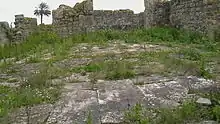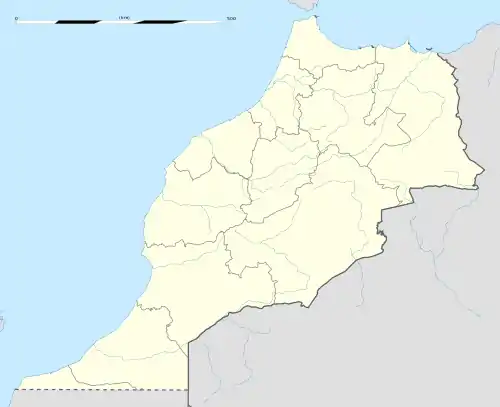Iulia Valentia Banasa
Iulia Valentia Banasa was a Roman city in northern Morocco. It was one of the three colonias in Mauretania Tingitana[1] founded by emperor Augustus between 33 and 25 BC for veterans of the battle of Actium.
 Roman ruins of Banasa: great occidental thermae | |
 Shown within Morocco | |
| Location | Sidi Ali Boujenoun, Kénitra Province, Rabat-Salé-Kénitra, Morocco |
|---|---|
| Coordinates | 34°36′06″N 06°06′56″W |
| Type | Settlement |
| History | |
| Builder | Augustus |
| Founded | Between 33 and 25 BC |
| Abandoned | Approximately 285 AD |
Characteristics
Iulia Valentia Banasa was located on the southern bank of the Sebou River on the site now known as Sidi Ali Boujenoun. At the start of the reign of Marcus Aurelius, Banasa became Colonia Aurelia Banasa. In 285 AD, the Roman province of Mauretania Tingitana was reduced to the territories located north of the Lixus. Banasa was then abandoned.[2]
Among the stone ruins at Iulia Valentia Banasa are some characteristic elements of ancient Roman architecture: a forum with a basilica, capitol and baths, as well as streets in a regular pattern. Many of the buildings date from the early third century AD. Beautiful mosaics decorated the buildings and now most are shown at the Rabat archeological museum[3]
The Latin name Valentia means young, strong and may be compared to Valence (France) and Valencia (Spain), also colonies. Augustus founded at least twelve Roman colonias in Mauretania, although it was a client-kingdom and not yet a province of the empire. Some of the other major Roman companion cities to Iulia Valentia Banasa of this early era are Chellah and Volubilis, the latter of which shares the features of basilica and regular street pattern.[4]
Objects recovered at Banasa may be seen at the Rabat Archaeological Museum.
Gallery

 Stone written in Latin
Stone written in Latin Section of Roman column
Section of Roman column View of Banasa ruins
View of Banasa ruins View of the Roman Forum and Basilica
View of the Roman Forum and Basilica
See also
References
- Dictionnaire de l'Antiquité. 2005
- William Seston. Tabula Banasitana ( Banasa )
- Banasa
- Hogan, C. Michael (2007). "Chellah". The Megalithic Portal, ed. A. Burnham.
Bibliography
- William Seston & Maurice Euzennat, « La citoyenneté romaine au temps de Marc Aurèle et de Commode, d'après la Tabula Banasitana », CRAI, 105-2, 1961, p. 317-324
External links
| Wikimedia Commons has media related to Banasa (Morocco). |
%252C_Algeria_04966r.jpg.webp)